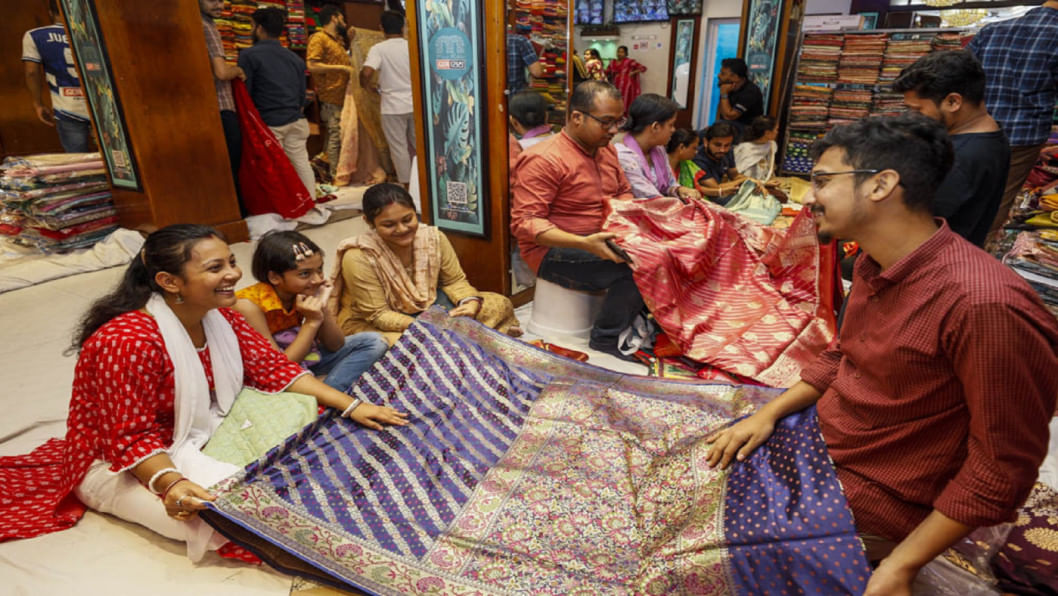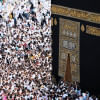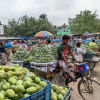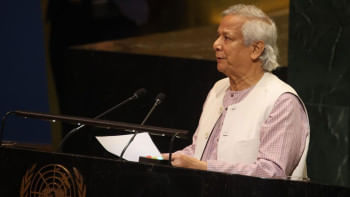Puja sales beat expectations, sari and panjabi top picks

Festival seasons are typically good for retailers, but this year many were cautious. Persisting inflation, weak consumer purchasing power, and economic uncertainty raised concerns that Durga Puja spending might falter.
Instead, sales not only picked up but, in many cases, exceeded expectations during the ten-day festival, the largest for Bangladesh's more than 13 million Hindus.
Soumik Das, manager of Rang Bangladesh, a popular fashion house with 19 outlets across the country, said, "We recorded a 10 percent year-on-year increase this Puja season."
Das attributed the growth to several factors, including the recent visa restriction by India. "Usually, many people visit India to shop this season. But due to the ban, those customers shifted to the local market."
Kay Kraft, another major fashion and lifestyle retailer with 14 outlets, also saw strong demand, particularly in Sylhet and in large malls such as Jamuna Future Park and Bashundhara City.
"There were some apprehensions about sales initially, but the overall response has been good. Sales were not bad. Some locations did better than others," said Khalid Mahmood Khan, co-founder and CEO of Kay Kraft.
"Some locations did better than others, but overall, the response has been good," he said, adding that the company was yet to analyse the reasons behind the location-based trend.
"IT'S A COLOURFUL TIME"
Industry insiders estimate that the two Eids generate about 70 percent of annual festival sales in Bangladesh, while Durga Puja and Pahela Baishakh account for the rest. Even so, the Puja season remains an important period for fashion retailers, with shoppers preparing weeks in advance and prioritising saris, panjabis, and accessories.
Consumers continue to favour red and white attire, though younger buyers are experimenting with other colours and prints. Discounts, bundle offers, and limited festive collections were used to attract customers.
Several large brands said this year's Puja season has yielded a good consumer response. Sales of saris and panjabis led the way.
Anjan's, a household name in festive wear with 22 stores across big cities, saw strong demand for its signature lines of saris, panjabis, salwar kameez, shirts, and fatuas.
"For Puja, red and white remain the most in-demand colours. This year we have experienced good sales," said Shaheen Ahmed, CEO of Anjan's. "Every festival has its own unique pattern, and for Puja, red and white colours are always in high demand."
Le Reve, another major player in ethnic and casual fashion, also reported brisk business. With 26 showrooms in major cities, the brand said its seasonal collections, featuring both traditional and new styles, were well received.
"Customers wait for new colours and trends every season," said CEO Monnujan Nargis.
Lanthon, a boutique retailer based at Aziz Super Market in Dhaka, also recorded positive sales.
According to its founder, Ujjal Akash, panjabis and saris in bright colours were the most popular purchases.
"It is a colourful time," he said, adding that the price range of Tk 1,000 to 1,500 attracted a wide group of buyers.
For individual buyers, this is the season to spend. Thirty-year-old Priyanka Chakraborty, a private jobholder, said, "I've been saving for months waiting for this festival. We exchange gifts among family members. I got myself a couple of kurtis, got another for my sister, and a sari and panjabi for my parents. I also got a few attires for my niece and nephews."
Subrata Chanda, another jobholder, said he bought a pair of shoes, a pair of pants, and shirts.
Businessman Shaikat K Das Ricky, a resident of Mirpur in the capital, said, "I bought a sari and a panjabi for my parents, spending Tk 6,000."
He added that, in addition, he received a gift shirt and a panjabi for himself.
Durga Puja, though centred on Bangladesh's Hindu community, has in recent years grown into a broader cultural occasion. For retailers, this year's festival was not just another seasonal boost but a sign that local brands can capture demand when external factors limit cross-border shopping.

 For all latest news, follow The Daily Star's Google News channel.
For all latest news, follow The Daily Star's Google News channel. 







Comments